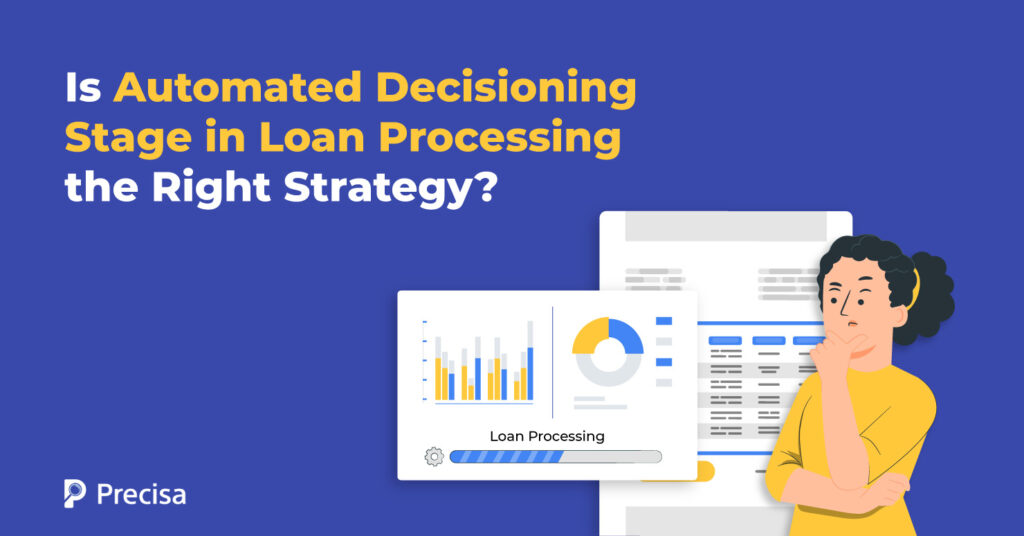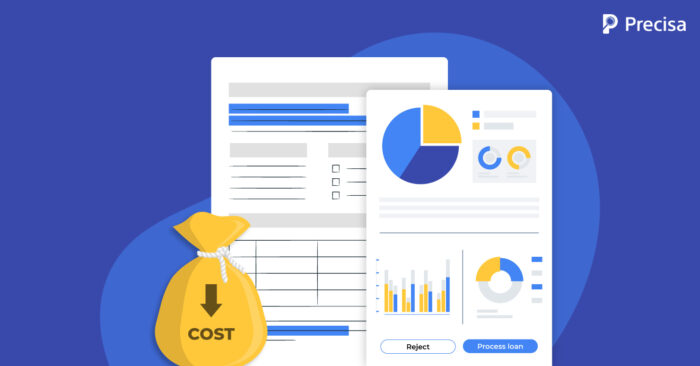Is Automated Decisioning Stage in Loan Processing the Right Strategy?

At the forefront of the significant transformation in lending operations is the automated decisioning stage in loan processing—a technological leap that’s reshaping how banks and financial institutions evaluate and approve loan applications.
Automated Decision-Making Systems, or ADMS leverage cutting-edge technologies such as Artificial Intelligence (AI), Machine Learning (ML), and advanced analytics to streamline the loan approval process.
But what exactly does this mean for lenders?
While the prospects of increased efficiency and reduced processing times is alluring, the adoption of ADMS in loan processing isn’t without its challenges.
In this article, we’ll explore the ins and outs of the automated decisioning stage in loan processing. We’ll uncover its potential benefits, address concerns, and examine how this technology is set to reshape the lending industry.
What Is the Automated Decisioning Stage in Loan Processing?
Banks and lending companies receive thousands of loan applications daily. Traditionally, a handful of specialised staff check these applications manually for approving or disapproving loans. This entire process of manual review is both time-consuming and exhausting.
In contrast, the automated decisioning stage in loan processing harnesses a variety of cutting-edge technologies to give lenders the speed and agility they need:
- Artificial Intelligence (AI): AI algorithms can process complex data sets and learn from past decisions to improve future accuracy.
- Machine Learning (ML): ML models continuously refine their decision-making capabilities based on new data and outcomes.
- Decision algorithms: These are sets of rules that guide the automated system in making consistent, objective loan decisions.
- OCR (Optical Character Recognition) technology: OCR enables the system to extract information from scanned documents, reducing manual data entry.
- Data Analytics: Advanced analytics tools help identify patterns and insights in large datasets, informing better decision-making.
5 Key Advantages of the Automated Decisioning Stage in Loan Processing?

Now, let us explore the major benefits of automated decision-making in loan processing:
Increased Employee Efficiency
With online facilities and automation, banks and financial institutions have not only alleviated employee workload but also helped them focus on their core responsibilities.
For example, the Michigan State University Federal Credit Union (MSUFCU) successfully implemented automated decision-making. Their average automation rate per month is over 55%. This helped MSUFCU decrease their time for processing loans/credit to below 24 hours.
Cost Reduction
When a lending company or bank uses automated decisioning, they require less manual labour for repetitive tasks. The labour hours for repetitive tasks such as document verification, data entry, and others decrease significantly.
Automated decision-making helps to process loans faster as operational efficiency improves. So, banks can process far more loan applications with the same workforce than traditional manual processing.
Eliminate Human Error or Bias
The automated decisioning stage in loan processing uses smart-contract-based algorithms based on predefined rules and conditions. This helps to evaluate all loan applicants on the same criteria.
Hence, the evaluation of all applications is done objectively, fairly, and without discrimination. Human biases and errors do not affect decision-making and approval of loan applications.
Mitigate Risk
Checking creditworthiness through manual loan processing usually involves checking recent bank statements. Automated decision-making tools, on the other hand, use ML models to assess credit risk by using historical data and many other factors.
That is why the latter identifies high-risk applicants and potential defaulters more effectively.
Better Compliance and Audit
Automated decision-making tools are helping banks adhere to regulations with the help of configurable workflows as well as decision rules. This, in turn, improves their compliance, lending efficiency and profitability.
However, the question is, how foolproof is this automated decisioning stage, and is it the right strategy for FIs? Aren’t there any risks or challenges in the process? Let us find out.
Automated Decisioning Stage in Loan Processing: Is Speed at the Cost of Fairness?
Automated decision-making offers lenders multiple advantages. However, it is not flawless. Over time, businesses and lenders have faced downsides with automated loan decisions:
- Flawed guidelines: Poor software settings can lead to unfair rejections or risky approvals.
- Data bias: Algorithms might perpetuate past lending biases against certain groups.
- Opacity: Complex algorithms make it hard for borrowers to understand loan rejections.
- Limited human touch: Complex cases or extenuating circumstances might be missed by the algorithm.
So, What is the Solution?
Therefore, instead of considering automated decision-making as a foolproof solution, here are some safeguards businesses should implement:
Human Oversight and Accountability:
Automated decision-making should never be fully autonomous. It’s essential to keep humans in the loop, especially for critical choices. Regular audits of ADM systems can help catch errors or biases before they become major issues.
Transparency and Explainability
“Black box” AI is a no-go. Lending businesses must use explainable AI techniques to shed light on how decisions are reached. This not only builds trust with users but also helps identify potential problems.
Data Quality and Bias Mitigation
Rigorous data cleaning and regular bias testing are essential to prevent discrimination or unfair outcomes. Involving diverse teams in the development process helps to identify and address potential biases early on.
Ethical Considerations
Regular ethical impact assessments can help identify potential negative consequences for individuals or society. Lenders must strive to use ADM in ways that align with their values and respect the rights of their users.
Regulatory Compliance
Lenders need to stay informed about relevant laws and regulations, such as the GDPR. Seeking legal counsel during implementation can help ensure compliance and avoid costly penalties.
Final Note
Automated decision-making systems can help lenders make informed credit decisions for reducing non-performing assets and making smarter investment decisions.
Precisa is a cloud-based, intuitive analytics solution designed for decision-makers in the fields of lending, insurance, wealth management, and personal finance
The platform offers core solutions including Bank Statement Analysis, which allows users to upload bank statements or fetch data directly from banks using an Account Aggregator connector for fast and accurate analysis. GSTR Analysis provides real-time fetching of GSTR data whereas the Credit Report Analysis feature enables real-time fetching of credit reports to provide a 360-degree view of a customer’s financial health.



